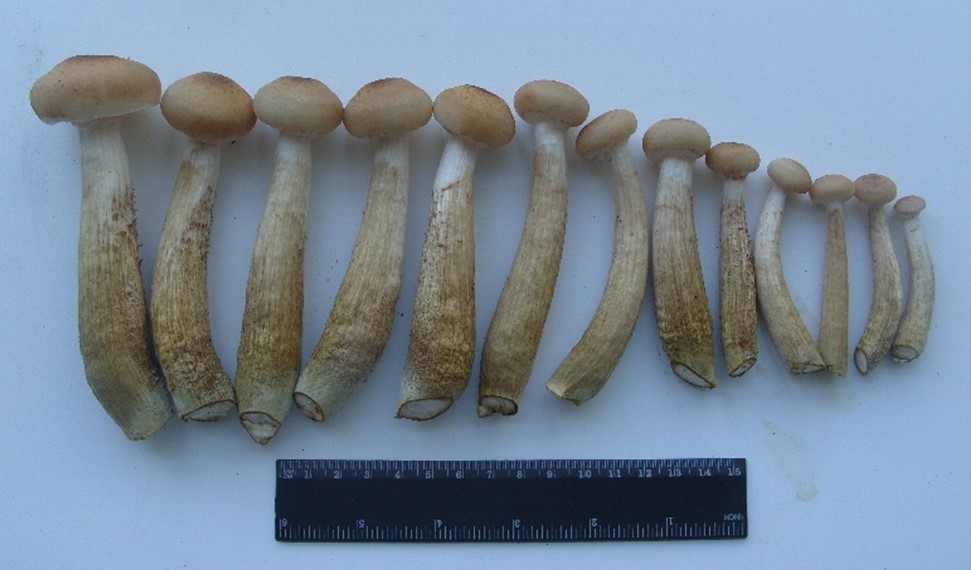ISOLATION, STRUCTURE AND PHYSICO-CHEMICAL PROPERTIES OF CHITIN-GLUCAN COMPLEXES OF HIGHER FUNGI
UDC 577.114.4
Abstract
The article is devoted to the study of isolation processes, chemical structure and rheological properties of chitin-glucan complexes from the biomass of Armillaria mellea. Because of the studies, it was found that the yield of chitin-glucan complexes ranged from 11.0 to 24.9% with a degree of deacetylation from 24 to 55%. The maximum yield was obtained by treating the fruiting bodies of fungi at the stage of deproteinization with a 3% aqueous solution of sodium hydroxide with mechanical stirring at 225 rpm for 60 min at 75±5°C. It is shown that the degree of deacetylation correlates with the values of the alkali concentration used. The IR spectra of the obtained samples of chitin-glucan complexes include absorption bands characteristic of stretching and bending vibrations of the bonds of chitin and glucan links and coincide with the spectra of chitin-glucan complexes of other fungi. It has been established that the viscosity characteristics of a 1% solution of a chitin-glucan complex in 2% hydrochloric acid are 14 and 190 times lower than 5% and 10% solutions, respectively. Increasing the shear rate makes it possible to detect a decrease in the viscosity of all studied solutions. Storage of a 1% solution of chitin-glucan complexes for 7 days at 25±2°C is accompanied by a decrease in viscosity; the viscosity of 5 and 10% solutions remains stable.
Downloads
Metrics
References
Jones M., Kujundzic M., John S., Bismarck A. Mar. Drugs., 2020, vol. 18, pp. 64. DOI: 10.3390/md18010064.
Nwe N., Furuike T., Tamura H. Advances in Polymer Science, 2011, pp. 187–207. DOI: 10.1007/12_2011_124.
Boureghda Y., Satha H., Bendebane F. Waste and Biomass Valorization, 2021, vol. 12, no. 11, pp. 1–15. DOI: 10.1007/s12649-021-01449-3.
Mahapatra S., Banerjee D. Microbiology Insights, 2013, vol. 6, pp. 1–16. DOI: 10.4137/MBI.S10957.
Araújo D., Ferreira I. C., Torres C. A., Neves L., Freitas F. Journal of Chemical Technology & Biotechnology, 2020, vol. 95, no. 5, pp. 1277–1289. DOI: 10.1002/jctb.6325.
Ospina Álvarez S.P., Ramírez Cadavid D.A., Escobar Sierra D.M., Ossa Orozco C.P., Rojas Vahos D.F., Zapata Ocampo P., Atehortúa, L. Biomed. Res. Int., 2014, pp. 1–7. DOI: 10.1155/2014/ 169071.
Liao J., Huang H. Int. J. Biol. Macromol., 2020, vol. 156, pp. 1279–1286. DOI: 10.1016/j.ijbiomac.2019.11.165.
Ivshina V.P., Artamonovab S.D., Ivshinaa T.N., Sharninaa F.F. Polymer Science, Ser. B., 2007, vol. 49, no. 11–12, pp. 305–310. DOI: 10.1134/S1560090407110097.
Araújo D., Rodrigues T., Alves V.D., Freitas F. Polymers, 2022, vol. 14, pp. 785. DOI: 10.3390/polym14040785.
Singh A., Dutta P.K., Kumar H., Kureel A.K., Rai A.K. J. Polym. Res., 2019, vol. 26, pp. 234. DOI: 10.1007/s10965-019-1893-3.
Abdel-Mohsen A.M., Jancar J., Massoud D., Fohlerova Z., Elhadidy H., Spotz Z., Hebeish A. Int. J. Pharm., 2016, vol. 510, pp. 86–99. DOI: 10.1016/j.ijpharm.2016.06.003.
Roy J.C., Salaün F., Giraud S., Ferri A., Chen G., Guan J. In Solubility of Polysaccharides. Xu, Z., Ed.; InTech: Rjeka, Croatia, 2017. DOI: 10.5772/intechopen.71385.
Shipovskaya A.B., Abramov A.Y., Pyshnograi G.V., Aziz A.J.H.N. Journal of Engineering Physics and Thermophys-ics, 2016, vol. 89, no. 3, pp. 642–651. DOI: 10.1007/s10891-016-1422-8.
Minakov D.V., Vereshchagin A.L., Morozhenko YU.V., Bazarnova N.G. Khimiya rastitel'nogo syr'ya, 2019, no. 1, pp. 251–257. DOI: 10.14258/jcprm.2019014368. (in Russ.).
Kuchina YU.A., Dolgopyatova N.V., Novikov V.YU., Sagaydachnyy V.A., Morozov N.N. Vestnik MGTU, 2012, vol. 15, no. 1, pp. 107–113. (in Russ.).
Riccardo A.A. Muzzarelli, Tanfani F., Gianfranco S. Industrial Wastes Biotechnology and Bioengineering, 1980, vol. XXII, pp. 885.
Shabrukova N.V., Shestakova L.M., Zainetdinova D.R., Gamayurova V.S. Butlerov Communications, 2002, vol. 2, pp. 57–59.
Zhang P., Sutheerawattananonda M. International Journal of Chemical Engineering, 2020, pp. 1–8. DOI: 10.1155/2020/5084036.
El-hefian E.A., Yahaya A.H. Maejo International Journal of Science and Technology, 2010, vol. 4, no. 2, pp. 210–220.
Sobral P.J., Gebremariam G., Drudi F., De Aguiar Saldanha Pinheiro A.C., Romani S., Rocculi P., Dalla Rosa M. Foods, 2022, vol. 11, pp. 2692. DOI: 10.3390/foods11172692.
Vshivkova S.A., Rusinovaa Ye.V., Abu Salekha A.S. Vysokomolekulyarnyye soyedineniya. Seriya A., 2021, vol. 63, no. 4, pp. 243–248. DOI: 10.31857/S2308112021040088. (in Russ.).
Bartenev G. M. Uspekhi kolloidnoy khimii. [Advances in colloidal chemistry]. Мoscow, 1973, pp. 17–183. (in Russ.).
Savitskaya T.A., Grinshpan D.D., Kimlenko I.M., Makarevich S.Ye., Tpan Day Lam, Fam Tkhi Lan. Sviridovskiye cht-eniya: sbornik statey. [Sviridovsky readings: a collection of articles]. Minsk, 2020. С. 123–136. (in Russ.).
Matveyenko V.H., Kirsanov Ye.A. Vestnik Moskovskogo universiteta. Khimiya, 2017, vol. 58, no. 2, pp. 59–81. (in Russ.).

Copyright (c) 2023 chemistry of plant raw material

This work is licensed under a Creative Commons Attribution 4.0 International License.

This work is licensed under a Creative Commons Attribution 4.0 International License.
The authors, which are published in this journal, agree to the following conditions:
1. Authors retain the copyright to the work and transfer to the journal the right of the first publication along with the work, at the same time licensing it under the terms of the Creative Commons Attribution License, which allows others to distribute this work with the obligatory indication of the authorship of this work and a link to the original publication in this journal .
2. The authors retain the right to enter into separate, additional contractual agreements for the non-exclusive distribution of the version of the work published by this journal (for example, to place it in the university depository or to publish it in a book), with reference to the original publication in this journal.
3. Authors are allowed to post their work on the Internet (for example, in a university repository or on their personal website) before and during the review process of this journal, as this may lead to a productive discussion, as well as more links to this published work.











